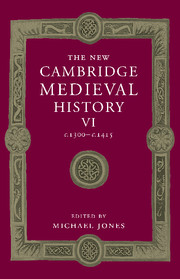Book contents
- Frontmatter
- Part I General Themes
- Part II The States of the West
- Part III The Church and Politics
- Part IV Northern and Eastern Europe
- 21 Baltic Europe
- 22 The Kingdoms of Central Europe in the Fourteenth Century
- 23 The Principalities of Rus’ in the Fourteenth Century
- 24 The Byzantine Empire in the Fourteenth Century
- 25 Latins in the Aegean and the Balkans in the Fourteenth Century
- 26 The Rise of the Ottomans
- 27 Christians and Muslims in the Eastern Mediterranean
- Appendix Genealogical Tables
- Primary Sources and Secondary Works Arranged by Chapter
- Index
- Frontispiece
- Plate section
- Map 4 Europe's trade, c. 1300
- Map 5 Europe's trade, c. 1400
- Map 7 The Hundred Years War to 1360
- Map 15 Russia, c. 1396
- Map 17 The Byzantine empire in the 1340s
- References
24 - The Byzantine Empire in the Fourteenth Century
from Part IV - Northern and Eastern Europe
Published online by Cambridge University Press: 28 March 2008
- Frontmatter
- Part I General Themes
- Part II The States of the West
- Part III The Church and Politics
- Part IV Northern and Eastern Europe
- 21 Baltic Europe
- 22 The Kingdoms of Central Europe in the Fourteenth Century
- 23 The Principalities of Rus’ in the Fourteenth Century
- 24 The Byzantine Empire in the Fourteenth Century
- 25 Latins in the Aegean and the Balkans in the Fourteenth Century
- 26 The Rise of the Ottomans
- 27 Christians and Muslims in the Eastern Mediterranean
- Appendix Genealogical Tables
- Primary Sources and Secondary Works Arranged by Chapter
- Index
- Frontispiece
- Plate section
- Map 4 Europe's trade, c. 1300
- Map 5 Europe's trade, c. 1400
- Map 7 The Hundred Years War to 1360
- Map 15 Russia, c. 1396
- Map 17 The Byzantine empire in the 1340s
- References
Summary
In the course of the fourteenth century, Byzantine society underwent a series of major changes, in some ways similar to those in western Europe, in other ways quite different, and complicated by the presence of external threats that progressively led to the dissolution of the state and the conquest of its territory. While economic, social and cultural developments show considerable vitality, the weakness of the state, radically reducing its ability to provide order and security for its subjects, could not but influence the dynamic of other developments. Innovation, in practice more often than in theory, was not lacking; on the contrary, the responses to new conditions often present interesting if contradictory aspects.
For political history, a new era begins not with the start of the century but rather with the recovery of Constantinople from the Latins by a small expeditionary force of Michael VIII Palaeologus, emperor of Nicaea since 1258. This event, which occurred on 25 July 1261, had been long desired by the leaders of the major Greek splinter states, the emperors of Nicaea and the despots of Epirus, and it had certainly been prepared by Michael VIII. The restoration of a Byzantine emperor in the old capital of the empire had certain important consequences. For one thing, it displaced the focus of interest of the rulers from Asia to Europe, as they had to deal with western claims. The papacy, Charles of Anjou, the house of Valois and the Venetians all became engaged in various efforts to retake Constantinople, so that there was hostility between Byzantium and at least one western power at almost any time between 1261 and 1314; in 1281, as in 1308, powerful coalitions were aligned against Byzantium
- Type
- Chapter
- Information
- The New Cambridge Medieval History , pp. 795 - 824Publisher: Cambridge University PressPrint publication year: 2000
References
- 1
- Cited by

